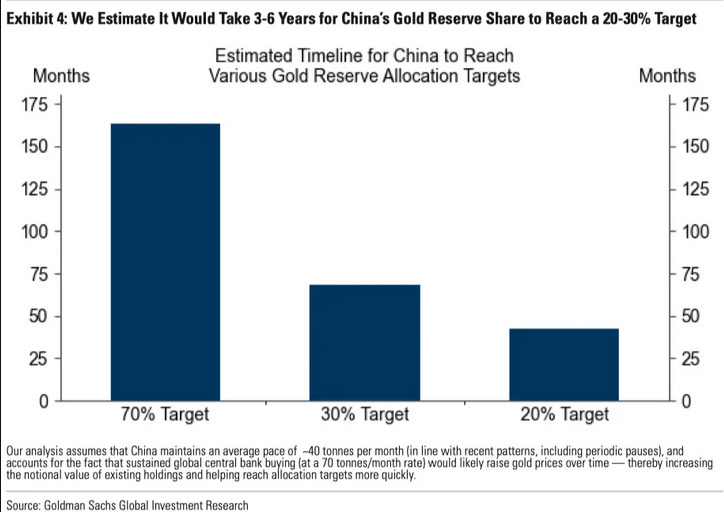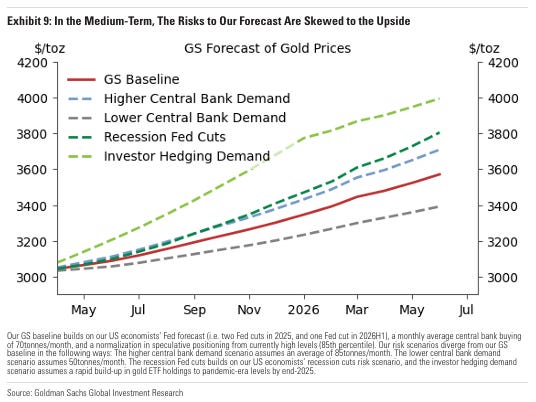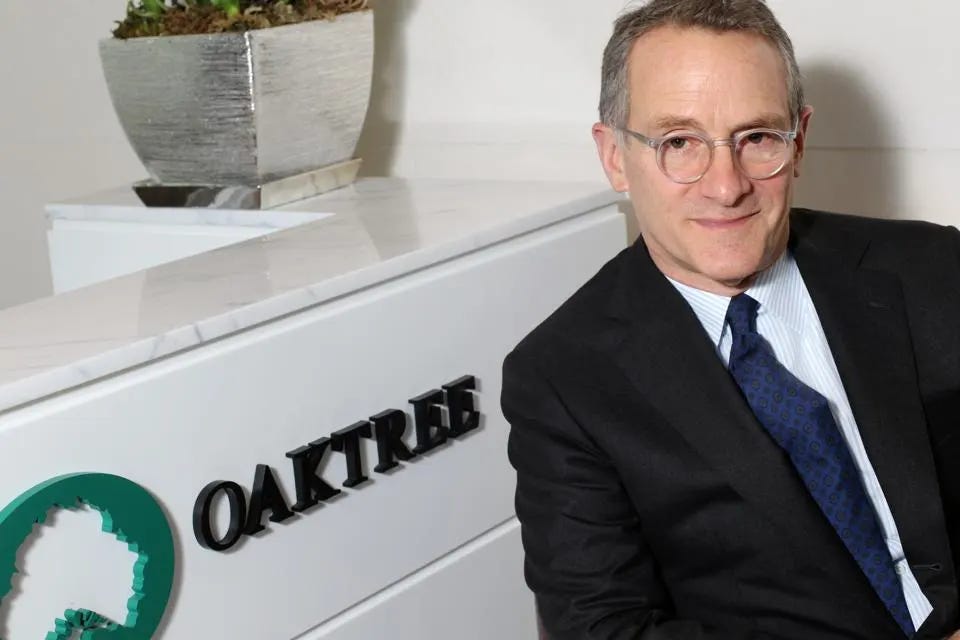Unlocked: Goldman Sees $4,500 Tail Risk in 2025, Raises all Targets
Bonus: Howard Marks April Market Commentary
Housekeeping: Good Morning. Excerpts from Howard Marks’ latest letter to investors is at bottom
Chinese Insurers’ New Gold Policy Drives Goldman’s $4,500 Forecast
Premium GoldFix content for Scottsdale Mint
(Full report here)
Last week Gold Soars 4% in 5 Days — Here’s Why was published exclusively for Scottsdale describing Bank of America’s rationale for raising their 2025 price target for Gold. The following analysis, issued practically the same day, breaks down Goldman Sachs rationale for revising their own target. 1
[Edit- GoldFix identifies the catalyst for both BOA and GS bank upgrades as China’s launch of insurance industry gold-demand covered herein- VBL]
Goldman’s latest analysis revises upward its year-end 2025 gold price target to $3,300/toz, raising the upper boundary of its forecast range to $3,520/toz and introducing a tail-risk scenario as high as $4,500/toz.
The revision stems primarily from upside surprises in ETF inflows and persistent, large-scale central bank gold purchases. The report also systematically answers key investor questions surrounding recent price behavior, structural demand drivers, and policy risks.
Structural Demand Surprises: The New Baseline
The analyst notes that the breakout above $3,000/toz on March 14 was catalyzed by a rebound in speculative positioning, as well as sustained ETF inflows and official sector purchases. In the six weeks leading to the breakout, speculative length fell by 150 tonnes, yet gold prices remained firm—a testament to the strength of structural demand. As positioning rebounded by 60 tonnes in response to tariff and “Mar-a-Lago accord” headlines, the price surged.
The bank’s baseline assumption is that central bank buying will average 70 tonnes/month, up from the prior 50 tonnes/month forecast. This estimate is based on:
A 109-tonne average pace in November-January.
Strategic diversification needs of EM central banks, particularly China.
Simultaneously, ETF demand has exceeded expectations. With Goldman economists projecting two Fed cuts in 2025 and one more in early 2026, inflows are likely to continue. History—specifically the COVID-19 period—shows such inflows can overshoot baseline expectations in extended periods of macro uncertainty.
Duration and Depth of Official Sector Buying
“The geopolitical hedging motive has gained relevance since the freezing of the Russian central bank assets in 2022.”
The analyst identifies central bank buying as a structurally persistent force. Since the 2022 asset freeze targeting Russian reserves, official buyers—especially in EM—have increased gold purchases roughly fivefold. The report argues that this represents a permanent shift in reserve management behavior.
China is a central case study: holding only 8% of reserves in gold versus a developed market average of ~70%. A move to 20% (considered a plausible medium-term target) would require three additional years of accumulation at 40 tonnes/month. This alone offers price support into the late 2020s.
Mar-a-Lago Accord Focus Enhances Gold’s Appeal
“Gold, unlike FX reserves, cannot be frozen or confiscated when held domestically.”
The report devotes a critical section to the November 2024 publication titled “A User’s Guide to Restructuring the Global Trading System” by Stephen Miran. Miran’s recommendations—including revaluing the dollar through tariff packages and terming out U.S. debt—carry tail-risk implications for gold.
While Goldman is skeptical of the political feasibility and market coordination required for such proposals, it acknowledges the hedging utility of gold amid rising focus on U.S. policy tail risks. Historical patterns suggest that even the discussion of reserve asset vulnerability enhances gold’s appeal to central banks.
Chinese Insurance Demand Will Be Massive
China’s policy shift allowing insurers to invest up to 1% of their AUM in gold—equivalent to ~280 tonnes—has not yet translated into significant flows. However, the analyst expects this latent demand to emerge during price corrections, providing a stabilizing effect on dips.
Two transmission channels are outlined:
Import-driven support for global gold prices (regulated by quotas).
Widening Shanghai premium if import constraints bind, signaling localized tightness.
China’s Gold-Insurance Program Begins…
The structure of China’s gold market, especially inventory levels and import quotas, will determine the precise mechanism by which insurance-driven demand expresses itself. Current Shanghai Gold Exchange inventories remain adequate due to weak jewelry demand, but the situation may evolve.
What Causes a Spike to $4,500
Goldman’s base case of $3,300 assumes:
70 tonnes/month central bank buying
Gradual ETF inflows
Normalizing speculative positioning
However, should the following materialize simultaneously:
Central bank buying hits 110 tonnes/month
ETF holdings return to COVID-era highs
Positioning exceeds historical peaks
… then gold could reach or exceed $4,200/toz by end-2025, with a plausible tail risk to $4,500/toz within the next 12 months. This scenario is considered low-probability, but Goldman highlights the asymmetric risk-reward for long gold positions—especially via call options.
Unfreezing Russian Assets and Margin-Driven Liquidation are Temporary Risks
Two key downside scenarios are identified, both of which the analyst believes would be short-lived:
A Russia-Ukraine peace deal: This could trigger a 3% speculative sell-off. Yet, central bank demand would remain anchored due to the structural precedent of the 2022 asset freeze, which redefined how reserve safety is perceived.
A sharp equity correction: Margin calls would trigger temporary liquidation of gold positions. However, historical behavior suggests speculative positioning would rebound rapidly in such high-uncertainty regimes.
In both cases, structural support remains intact, particularly from China’s newly authorized 280t insurance sector allocation, which the bank suggests will provide a price floor on dips.
Final View: Entry Points and Policy Risk Hedging
The bank reaffirms in its original report its long gold recommendation, citing:
Structural central bank accumulation
Rebounding ETF interest
Persistent policy risk exposure
While acknowledging that peace talks or equity volatility could provide cheaper entry points, the analyst maintains that pullbacks will be short-lived due to entrenched macro drivers.
This positioning aligns closely with broader asset reallocation narratives observed across EM central banks and Chinese institutional investors, both of whom are adjusting their portfolios to reflect a new paradigm—one in which trust in Western reserves is no longer absolute.
The implication is clear: gold’s bid remains underwritten by geopolitics, policy asymmetry, and systemic hedging behavior. This undercurrent, once latent, is now being quantified—and priced in.
////////END/////////
Exclusively for Premium Subscribers:
Howard Marks’ latest missive to Oaktree investors titled “Nobody knows (yet again)” discusses where we are (Tariffs) , in context of where we’ve been ( The GFC) , and where we are going (See his title).
Enjoy responsibly please…











